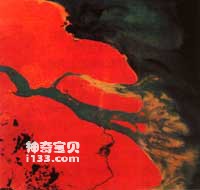Rivers carry a large amount of land material and pour it into the ocean through their mouths. The land material that enters the ocean with river water is mainly sediment. Rivers around the world carry 17 billion tons of sediment into the sea every year. In addition to sediment, there are also dissolved substances, and as much as 4.5 billion tons enter the sea every year. These dissolved substances serve as nutrients for marine life and promote the growth of marine life. The shells and skeletons of dead marine organisms also become sediments like sediment and participate in the shaping of the coast.

This is the mouth of the Yangtze River and the southern coast of Jiangsu. The light-colored areas are shoals and sandbars.

Schematic diagram of the morphological changes of the Yellow River Estuary
Terrestrial materials carried by river water are the main components of coastal sediments. Compared with the sediment caused by the impact of waves and sea erosion, it is a ratio of 99 to 1.
River sediment forms a delta coast in the estuary area. Delta-accumulated coasts spread rapidly seaward. During the Yangtze River Delta's seaward expansion in the past 2,000 years, it created 7,500 square kilometers of land. The modern Yellow River Delta advances 33 meters to the sea every year. The Pearl River Delta stretches 70-130 meters to the sea every year. The Mississippi River in the United States is also an expert at building land, with its delta advancing an average of 75 meters to the sea every year.

When the river flows into the estuary of the Minjiang River in Fujian, the sea sediment causes changes in the position and contour of the coastline. For example, in the bays around Qinhuangdao and Shanhaiguan in Hebei Province, my country, gravel deltas continue to expand into the sea due to the injection of river sand. This trend of coastal movement toward the sea has been reversed in recent years due to the construction of reservoirs and sluices on rivers. The amount of sediment entering the sea has decreased, and due to the large-scale dredging of sand due to the development of the construction industry, the scouring effect of waves on the beach has increased, making the beach of Beidaihe Bathing Beach in the famous scenic tourist area narrow, and some breakwaters and changing rooms were damaged. Some bunkers built on the beach in the 1950s also collapsed into the sea due to beach erosion.

The Luanhe River, which originates from the foothills of Bayantugul Mountain in the northwest of Fujian Province at the mouth of the Minjiang River and enters the sea in Leting County, is a large river in North China. Before the completion of the water conservancy project to divert Luanhe River to Tianjin in 1979, Luanhe Estuary received sufficient supply of sediment, causing the beach to silt up rapidly. After the completion of the diversion project from Luanhe River to Tianjin, as the Panjiakou and Daheiting reservoirs built on the Luanhe River began to store water, the amount of sediment released into the sea at the mouth of the river decreased sharply, causing the Luanhekou beach to stop silting up and even eroding and receding. The Daqing River estuary, located on the south side of the Luanhe River mouth, was once the channel where the Luanhe River entered the sea. Later, due to the change of course of the Luan River, there was no longer a supply of sediment, and the beach showed obvious erosion and retreat.
Things in nature are complex. River sedimentation creates land, and when the amount of sediment changes, the delta coast also changes. If a river flows into a coast dominated by sea erosion, there will be a battle between sedimentation and sea erosion, creating unique coastal landform units. Coasts that are mainly composed of biological processes, such as coral reef coasts, will also experience interesting phenomena once rivers intervene.
animal tags:
We created this article in conjunction with AI technology, then made sure it was fact-checked and edited by a Animals Top editor.